These best Orange Flowers are a great way to brighten up your homes and gardens with fascinating orange blossoms!
If you love the season of fall, then you must be fond of the orange shade. This beautiful color has the happiness of yellow and the energy of red color. It symbolizes fascination, creativity, attraction, success, encouragement, stimulation, and determination. You can bring all these attributes to your home or garden by planting these best Types of Orange Flowers!
Check out Orange Wildflowers You Can Grow in Your Yard
Orange Flowers
1. Pocketbook Plant
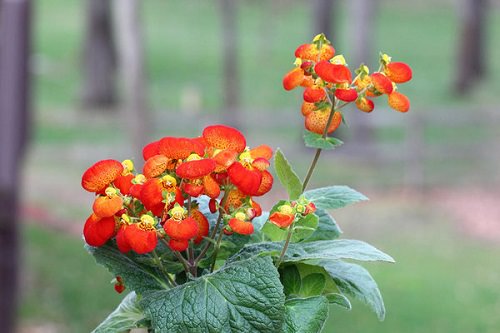
Botanical Name: Calceolaria crenatiflora
| Specification | Description |
|---|---|
| USDA Growing Zones | 10 to 12 |
| Color Varieties | Yellow, orange, red, or brown, sometimes with spots |
| Sun Exposure | Bright but indirect light |
| Soil Needs | Well-drained, loose, and slightly damp soil |
| Size (tall x wide) | 15 to 60 cm tall, 15 to 30 cm wide (6 to 24 in tall, 6 to 12 in wide) |
It is also known as a lady’s purse, slipper flower, and slipperwort. The pouch-shaped flowers come in orange, red-brown, and yellow colors speckled with contrasting shades.
2. Orange Lily

Botanical Name: Lilium bulbiferum var. croceum
| Specification | Description |
|---|---|
| USDA Growing Zones | 4 to 8 |
| Color Varieties | Violet-blue, rarely pink or white |
| Sun Exposure | Full sun or partial shade |
| Soil Needs | Moist, rich, well-drained, slightly acidic soil |
| Size (tall x wide) | 0.3 m tall, 0.1 m wide (1 ft tall, 4 in wide) |
Popularly known as fire lily, this hardy and ornamental lily is prized with flamboyant orange flowers are spotted with deep chocolate freckles. The flower’s color deepens to red towards the petal tips.
3. Lantana
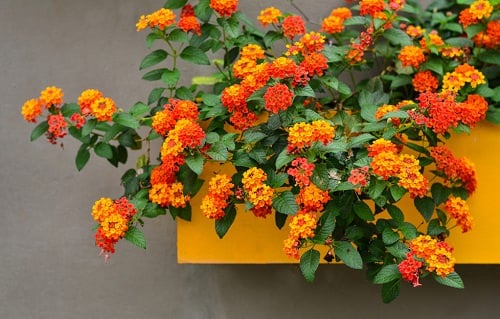
Botanical Name: Lantana camera
| Specification | Description |
|---|---|
| USDA Growing Zones | 9 to 11 |
| Color Varieties | Red, yellow, orange, pink, white, or mixed |
| Sun Exposure | Full sun or partial shade |
| Soil Needs | Well-drained, sandy, and not too wet |
| Size (tall x wide) | 0.6 to 1.8 m tall, 0.9 to 1.5 m wide (2 to 6 ft tall, 3 to 5 ft wide) |
Lantana displays clusters of tiny flowers in orange, red, and yellow shades. This tropical plant is ideal for hanging baskets.
4. Orange Pansy

Botanical Name: Viola tricolor var. hortensis ‘Nature Orange’
| Specification | Description |
|---|---|
| USDA Growing Zones | 6 to 10 |
| Color Varieties | Orange with black blotch |
| Sun Exposure | Full sun or partial shade |
| Soil Needs | Moist, fertile, well-drained soil |
| Size (tall x wide) | 15 to 20 cm tall, 10 to 15 cm wide (6 to 8 in tall, 4 to 6 in wide) |
This pansy from the nature series shows off bright, cheery orange flowers that will stand out like a flare when planted in a hanging basket or window box.
5. Painted Abutilon
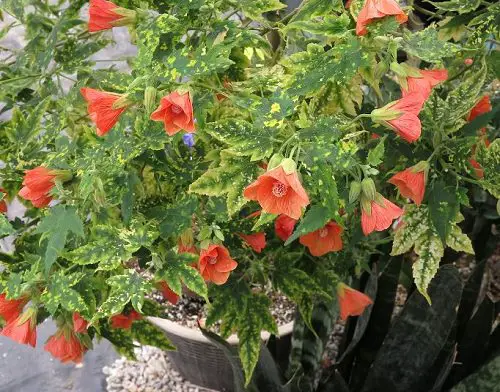
Botanical Name: Abutilon pictum ‘Thompsonii’
| Specification | Description |
|---|---|
| USDA Growing Zones | 9 to 11 |
| Color Varieties | Red, yellow, orange, pink, white, or mixed |
| Sun Exposure | Full sun or partial shade |
| Soil Needs | Well-drained, sandy, and not too wet |
| Size (tall x wide) | 0.6 to 1.8 m tall, 0.9 to 1.5 m wide (2 to 6 ft tall, 3 to 5 ft wide) |
‘Painted Abutilon’ is a vigorous evergreen shrub that bears showy, bell-shaped, light-orange, dangling flowers from spring to fall. The variegated maple-like glossy foliage is mottled with yellow color, complementing the beauty of the entire plant.
6. Orange Tulip
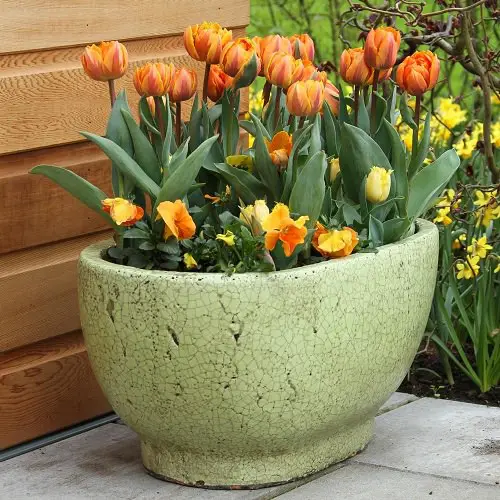
Botanical Name: Tulipa ‘Orange Princess’
| Specification | Description |
|---|---|
| USDA Growing Zones | 6 to 10 |
| Color Varieties | Orange with black blotch |
| Sun Exposure | Full sun or partial shade |
| Soil Needs | Moist, fertile, well-drained soil |
| Size (tall x wide) | 15 to 20 cm tall, 10 to 15 cm wide (6 to 8 in tall, 4 to 6 in wide) |
Tulips are available in almost every color; the orange variety is a beautiful, fragrant peony-flowered tulip, which is adorned with light orange petals, blushed with red-purple and polished with warm pink. The bowl-shaped flowers have green tips on the outer petals.
7. Butterfly Weed
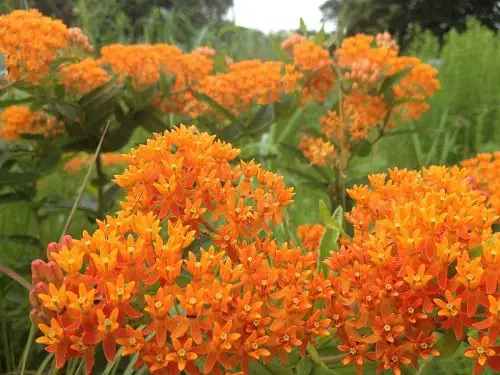
Botanical Name: Asclepias tuberosa
| Specification | Description |
|---|---|
| USDA Growing Zones | 3 to 9 |
| Color Varieties | Orange or yellow |
| Sun Exposure | Full sun |
| Soil Needs | Dry to medium, well-drained soil |
| Size (tall x wide) | 1 to 2 feet tall, 1 to 1.5 feet wide |
‘Butterfly weed’ is a good choice if you want to attract butterflies in your garden. It features crown-shaped tiny flowers that make a cluster of 2 inches across. During fall, the upright pods open, releasing seeds sparkling with silky hairs.
8. Chinese Lantern Plant

Botanical Name: Physalis alkekengi
| Specification | Description |
|---|---|
| USDA Growing Zones | 4 to 8 |
| Color Varieties | White flowers, orange or red fruit covers |
| Sun Exposure | Full sun or partial shade |
| Soil Needs | Moist, well-drained soil |
| Size (tall x wide) | 60 cm tall, 60 cm wide (2 ft tall, 2 ft wide) |
The ‘Chinese Lantern’ plant features heart-shaped leaves and white flowers. This plant is grown for the 2-inch wide papery pods or ‘calyxes’ that surround the fruits. The pods look like bright orange ‘Chinese lanterns,’ hence the name.
Note: The unripe berries are toxic. This plant belongs to the nightshade family, which includes many toxic plants like angel’s trumpet and bittersweet nightshade.
9. Oriental Poppy
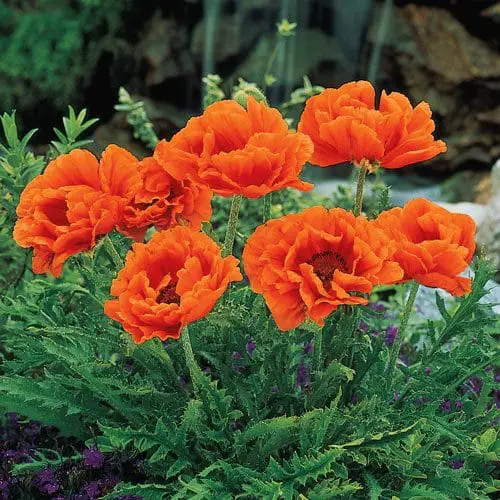
Botanical Name: Papaver orientale
| Specification | Description |
|---|---|
| USDA Growing Zones | 3 to 9 |
| Color Varieties | Orange, red, pink, purple, white, or mixed |
| Sun Exposure | Full sun or partial shade |
| Soil Needs | Moist, well-drained soil |
| Size (tall x wide) | 1 to 3 feet tall, 1 to 2 feet wide |
The cup-shaped, large, papery, bright tangerine flowers have black spots at the base of the petals. This showy flower blooms from late spring to early summer.
10. Calendula
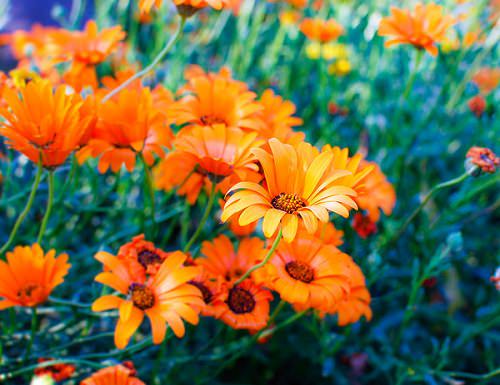
Botanical Name: Calendula officinalis
| Specification | Description |
|---|---|
| USDA Growing Zones | 6 to 10 |
| Color Varieties | Yellow or orange |
| Sun Exposure | Full sun or partial shade |
| Soil Needs | Moist, fertile, well-drained soil |
| Size (tall x wide) | 80 cm tall, 60 cm wide (31 in tall, 24 in wide) |
Calendula, or pot marigold, produces beautiful orange-yellow flowers that have had various culinary and medicinal uses since ancient times. This cold-hardy plant is ideal for flower beds or containers.
11. Crocosmia

Botanical Name: Crocosmia ‘lucifer’
| Specification | Description |
|---|---|
| USDA Growing Zones | 6 to 10 |
| Color Varieties | Red with black blotch |
| Sun Exposure | Full sun or partial shade |
| Soil Needs | Moist, fertile, well-drained soil |
| Size (tall x wide) | 1.2 to 2.1 m tall, 0.3 to 0.6 m wide (4 to 7 ft tall, 1 to 2 ft wide) |
This attractive variety forms bright orange or red flowers in spikes with a dense clump of upright, sword-like foliage in late summer. Crocosmia ‘Lucifer’ is popular for attracting bees.
12. Indian Shot

Botanical Name: Canna indica
| Specification | Description |
|---|---|
| USDA Growing Zones | 9 to 11 |
| Color Varieties | Red, yellow, orange, pink, white, or mixed |
| Sun Exposure | Full sun or partial shade |
| Soil Needs | Well-drained, sandy, and not too wet |
| Size (tall x wide) | 0.6 to 1.8 m tall, 0.9 to 1.5 m wide (2 to 6 ft tall, 3 to 5 ft wide) |
This plant looks attractive with wide and long, banana-like leaves in bronze, green, or striped patterns. The burgundy stems bear bright orange flowers with droopy petals.
13. Orange Zinnia

Botanical Name: Zinnia elegans ‘Queeny Orange’
| Specification | Description |
|---|---|
| USDA Growing Zones | 6 to 10 |
| Color Varieties | Orange with black blotch |
| Sun Exposure | Full sun or partial shade |
| Soil Needs | Moist, fertile, well-drained soil |
| Size (tall x wide) | 15 to 20 cm tall, 10 to 15 cm wide (6 to 8 in tall, 4 to 6 in wide) |
Zinnia offers flowers in several different colors, including many shades of orange. ‘Queeny Orange’ offers 2-3 inches wide, solitary flowerheads in coral orange shades. It blooms for an extended period from early summer to frost.
14. Trumpet Vine
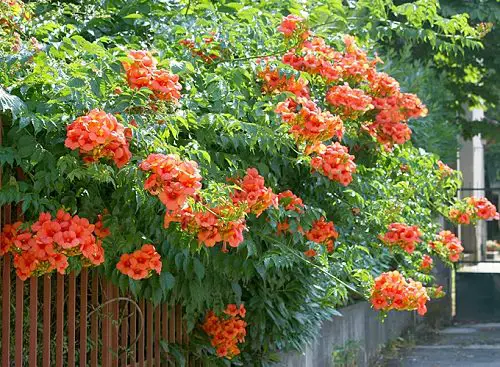
Botanical Name: Campsis radicans
| Specification | Description |
|---|---|
| USDA Growing Zones | 4 to 9 |
| Color Varieties | Red, orange, or yellow |
| Sun Exposure | Full sun or partial shade |
| Soil Needs | Average, moist but well-drained soil |
| Size (tall x wide) | 25 to 40 feet long, 5 to 10 feet wide |
This climber grows orange to salmon flowers in summer. Support trumpet vine with a trellis, arbor, or fence, and it will climb beautifully. It is also a great plant to attract hummingbirds.
15. Orange Impatiens
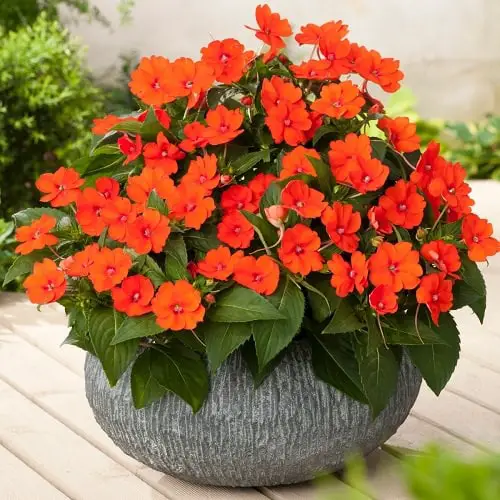
Botanical Name: Impatiens walleriana ‘Sunpatiens Compact Orange’
| Specification | Description |
|---|---|
| USDA Growing Zones | 6 to 10 |
| Color Varieties | Orange with black blotch |
| Sun Exposure | Full sun or partial shade |
| Soil Needs | Moist, fertile, well-drained soil |
| Size (tall x wide) | 15 to 20 cm tall, 10 to 15 cm wide (6 to 8 in tall, 4 to 6 in wide) |
Impatiens can be grown in both partial sun and full shade. They are available in a range of varieties and tones. The ‘Sunpatiens Compact Orange’ variety offers bright orange 2-3 inches wide flowers that beautifully contrast with dark green foliage.
Check out Orange Succulents
16. Orange Nasturtium
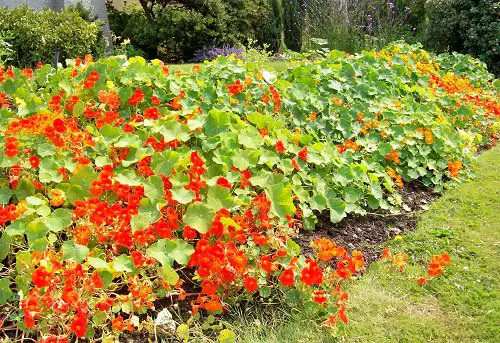
Botanical Name: Tropaeolum Majus ‘Double Gleam Orange’
| Specification | Description |
|---|---|
| USDA Growing Zones | 3-10 |
| Color Varieties | Bright orange flowers with dark green leaves |
| Sun Exposure | Full sun |
| Soil Needs | Poor, well-drained, pH 6.1 – 7.8 |
| Size (tall x wide) | 60 cm tall x 90 cm wide (24 in x 36 in) |
Enjoy the beauty of this nasturtium variety all summer long. It features fragrant, vivid, semi-double flowers in orange color. This variety also goes with the name trailing nasturtium and can reach up to 40-60 inches in length.
17. Mexican Sunflower

Botanical Name: Tithonia rotundifolia
| Specification | Description |
|---|---|
| USDA Growing Zones | 3-11 |
| Color Varieties | Yellow, orange, or red flowers with dark green leaves |
| Sun Exposure | Full sun |
| Soil Needs | Poor to average, well-drained, acidic soil |
| Size (tall x wide) | 60-250 cm x 45-90 cm (24-100 in x 18-36 in) |
Native to Mexico and Central America, it is an annual that can grow up to 4-6 feet tall. The bright orange flowers with raised yellow centers attract scores of butterflies in the garden. It blooms from summer through to fall.
18. Crown Imperial
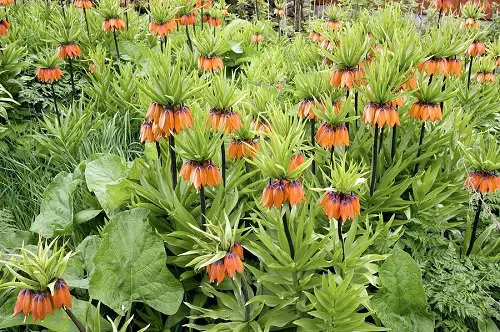
Botanical Name: Fritillaria imperialis
| Specification | Description |
|---|---|
| USDA Growing Zones | 5 to 9 |
| Color Varieties | Orange, red, or yellow flowers with dark green leaves |
| Sun Exposure | Full sun to part shade |
| Soil Needs | Sandy, well-drained, acidic, neutral, or alkaline soil |
| Size (tall x wide) | 90 to 120 cm x 25 to 40 cm (36 to 48 in x 10 to 16 in) |
It is a spring-flowering bulb that forms orange, red, or yellow flowers. The unique-looking flower beautifully dangles like a ‘bell.’ The inside markings consist of six round, glossy, white spots close to the base of each petal.
19. Carnation Chabaud Orange
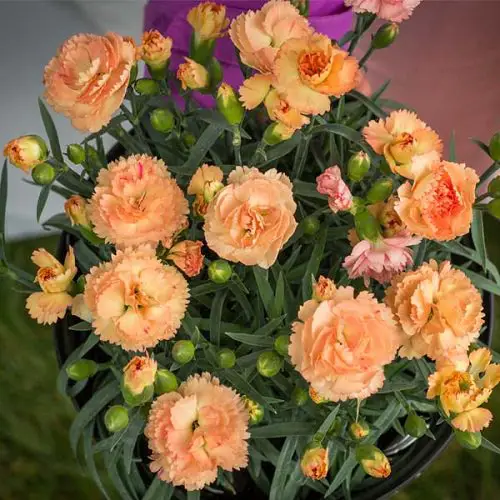
Botanical Name: Dianthus caryphyllus ‘Chabaud Orange’
| Specification | Description |
|---|---|
| USDA Growing Zones | 6 to 10 |
| Color Varieties | Bright orange flowers with dark green leaves |
| Sun Exposure | Full sun to partial shade |
| Soil Needs | Well-drained, pH 6.6 to 7.8 |
| Size (tall x wide) | 60 cm x 90 cm (24 in x 36 in) |
This carnation hybrid offers you fragrant, large, peach-orange double-flowers with ruffled petals. It flowers from late spring to mid-summer.
20. Gerbera Daisy
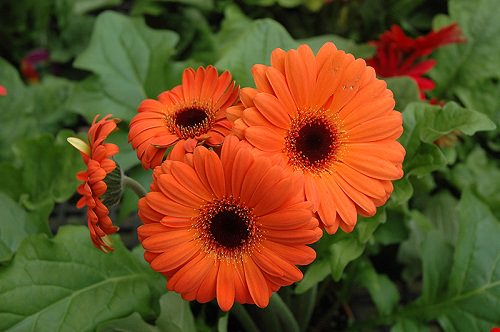
Botanical Name: Gerbera jamesonii
| Specification | Description |
|---|---|
| USDA Growing Zones | 8 to 10 |
| Color Varieties | Red, yellow, orange, pink, or white flowers with dark green leaves |
| Sun Exposure | Full sun to partial shade |
| Soil Needs | Moist, well-drained, rich in organic matter, pH 6.1 to 7.8 |
| Size (tall x wide) | 25 to 45 cm x 23 to 30 cm (10 to 18 in x 9 to 12 in) |
Orange gerberas are praised for their daisy-like, bright, lively flowers with green, woolly foliage. The orange varieties include: Jaguar ‘Deep Orange’, Jaguar ‘Tangerine,’ and Jaguar ‘Orange Fire.’
21. Orange Persian Buttercup

Botanical Name: Ranunculus asiaticus ‘Tecolote Orange’
| Specification | Description |
|---|---|
| USDA Growing Zones | 8 to 11 |
| Color Varieties | Bright orange flowers with dark green leaves |
| Sun Exposure | Full sun to part shade |
| Soil Needs | Sandy, well-drained, acidic, neutral, or alkaline soil |
| Size (tall x wide) | 40 to 45 cm x 30 to 60 cm (16 to 18 in x 12 to 24 in) |
Persian buttercup produces long-lasting, rose-like, large, bright orange flowers embellished with multiple silky, delicate petals with lime-green centers.
22. Torch Lily
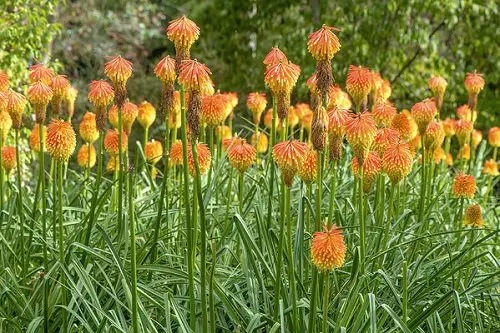
Botanical Name: Kniphofia ‘Nobilis’
| Specification | Description |
|---|---|
| USDA Growing Zones | 5 to 9 |
| Color Varieties | Orange-red flowers fading to yellow, with dark green leaves |
| Sun Exposure | Full sun to part shade |
| Soil Needs | Sandy, well-drained, acidic, neutral, or alkaline soil |
| Size (tall x wide) | 150 to 180 cm x 60 to 90 cm (60 to 72 in x 24 to 36 in) |
This late-flowering perennial forms tall, vigorous, long spikes of bright orange-red tubular flowers that fade to yellow in late summer to early fall. It has won the Award of Garden Merit of the Royal Horticultural Society.
23. Orange Sneezeweed
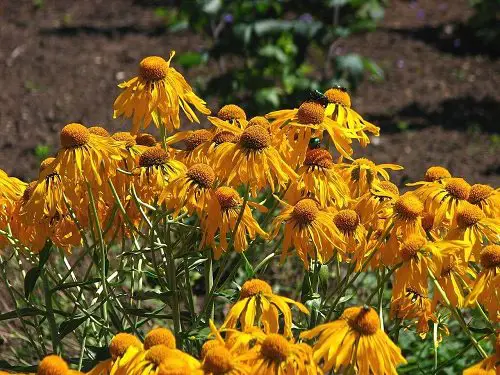
Botanical Name: Helenium hoopesii
| Specification | Description |
|---|---|
| USDA Growing Zones | 3 to 8 |
| Color Varieties | Orange-yellow flowers with dark green leaves |
| Sun Exposure | Full sun to part shade |
| Soil Needs | Sandy, well-drained, acidic, neutral, or alkaline soil |
| Size (tall x wide) | 90 cm x 50 cm (36 in x 20 in) |
Native to North America, this Helenium forms branched clusters of brilliant golden orange-yellow flowers with serrated ray petals. It has a central cone with golden pollens that attract butterflies.
24. Lion’s Tail
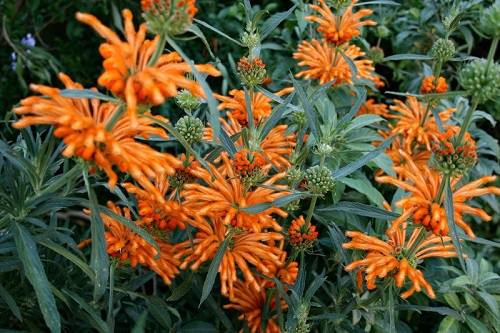
Botanical Name: Leonotis leonurus
| Specification | Description |
|---|---|
| USDA Growing Zones | 8 to 11 |
| Color Varieties | Orange-red flowers with dark green leaves |
| Sun Exposure | Full sun to part shade |
| Soil Needs | Sandy, well-drained, acidic, neutral, or alkaline soil |
| Size (tall x wide) | 150 to 180 cm x 60 to 90 cm (60 to 72 in x 24 to 36 in) |
This dazzling semi-evergreen shrub produces tubular, two-lipped, fuzzy orange flowers tiered in whorls around the top half of upright stems. It flowers from late spring through fall.
25. California Poppy
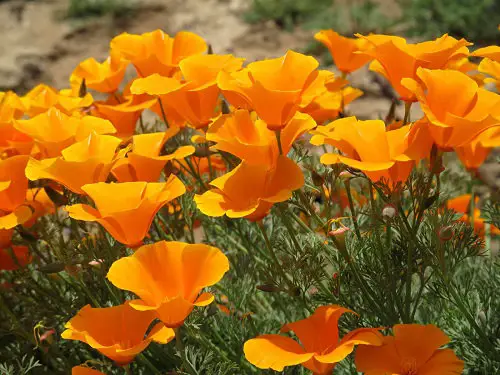
Botanical Name: Eschscholzia californica
| Specification | Description |
|---|---|
| USDA Growing Zones | 3–10 (perennial in zones 6–10) |
| Color Varieties | Orange, yellow, red, pink, or white flowers with dark green leaves |
| Sun Exposure | Full sun |
| Soil Needs | Sandy, well-drained, acidic, neutral, or alkaline soil |
| Size (tall x wide) | 25 to 45 cm x 23 to 30 cm (10 to 18 in x 9 to 12 in) |
Also known as a cup of gold, California sunlight, and golden poppy, this ornamental plant features cup-shaped flowers that are also used as a garnish in food recipes. Also, it has been declared the official state flower of California in 1903.
26. Orange Begonia 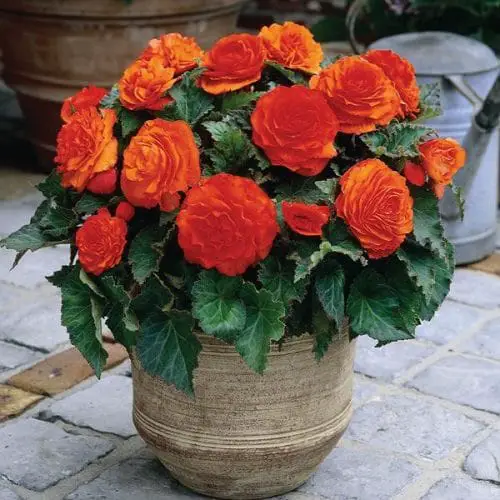
Botanical Name: Begonia x tuberhybrida ‘Nonstop Orange’
| Specification | Description |
|---|---|
| USDA Growing Zones | 10 to 11 |
| Color Varieties | Bright orange flowers with dark green leaves |
| Sun Exposure | Part shade to shade |
| Soil Needs | Moist but well-drained, rich in organic matter, pH 6.6 to 7.8 |
| Size (tall x wide) | 20 to 30 cm x 30 to 40 cm (8 to 12 in x 12 to 16 in) |
This beautiful variety displays beautiful double flowers that resemble roses with their vibrant orange petals from late spring to frost. Hot weather tolerant, Begonia ‘Nonstop Orange’ belongs to the ‘Nonstop’ series.
27. Bird of Paradise
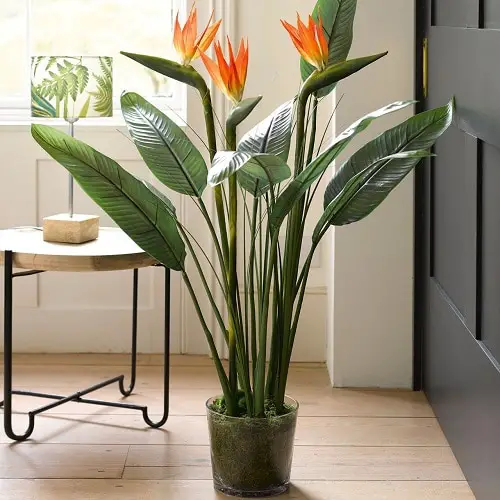
Botanical Name: Strelitzia reginae
| Specification | Description |
|---|---|
| USDA Growing Zones | 10 to 12 |
| Color Varieties | Orange and blue flowers with dark green leaves |
| Sun Exposure | Full sun to part shade |
| Soil Needs | Loamy, well-drained, acidic, neutral, or alkaline soil |
| Size (tall x wide) | 120 to 180 cm x 90 to 120 cm (48 to 72 in x 36 to 48 in) |
The bird of paradise produces bold, elongated orange flowers with hints of blue. It beautifully rises above the pointy dark green foliage from late winter to late fall.
28. Orange Stalked Bulbine
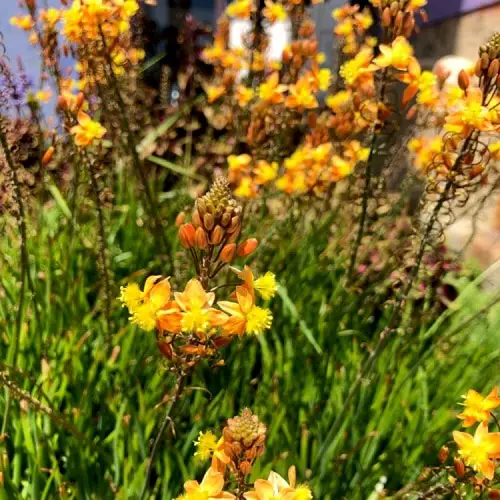
Botanical Name: Bulbine frutescens ‘Orange’
| Specification | Description |
|---|---|
| USDA Growing Zones | 9 to 11 |
| Color Varieties | Yellow or pale orange flowers with dark green leaves |
| Sun Exposure | Full sun to partial shade |
| Soil Needs | Dry to moist, well-drained sandy loam |
| Size (tall x wide) | 30 to 45 cm x 90 to 120 cm (12 to 18 in x 36 to 48 in) |
Native to South Africa, it features tall flower stalks with succulent foliage. The small buds flaunt distinct green stripes, deep orange petals, and frilly yellow stamens.
29. Orange Chrysanthemum

Botanical Name: Chrysanthemum ‘Hailey Orange’
| Specification | Description |
|---|---|
| USDA Growing Zones | 5 to 9 |
| Color Varieties | Bright orange flowers with dark green leaves |
| Sun Exposure | Full sun to part shade |
| Soil Needs | Average, medium moisture, well-drained |
| Size (tall x wide) | 30 to 40 cm x 30 to 40 cm (12 to 16 in x 12 to 16 in) |
This decorative variety of Chrysanthemum sports bright orange flowers with broad petals. It is ideal for embellishing fall landscapes or borders. You can also try other orange Chrysanthemum varieties like*: ‘Dazzling Stacy,’ ‘Miranda Orange,’ ‘Mumosa Orange,’ ‘Pop Eye Orange,’ and ‘Sunset Orange.’
30. Orange Cosmos
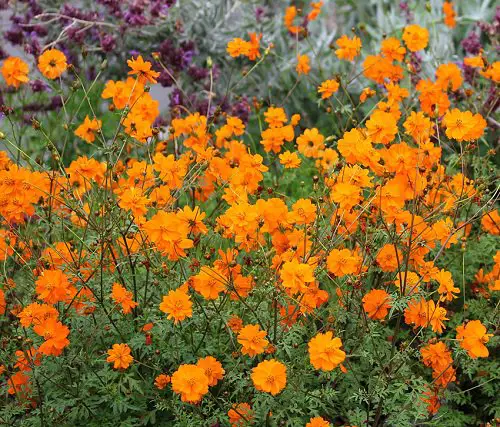
Botanical Name: Cosmos sulphereus ‘Cosmic Orange’
| Specification | Description |
|---|---|
| USDA Growing Zones | 2 to 11 (perennial in zones 6 to 11) |
| Color Varieties | Bright orange flowers with dark green leaves |
| Sun Exposure | Full sun |
| Soil Needs | Sandy, well-drained, acidic, neutral, or alkaline soil |
| Size (tall x wide) | 60 cm x 45 cm (24 in x 18 in) |
This compact, semi-hardy, annual flower showcases vibrant, semi-double orange flowers with fern-like foliage on sturdy stems from early summer to fall.
Look at the Tropical Plants With Orange Flowers
31. Orange Dahlia
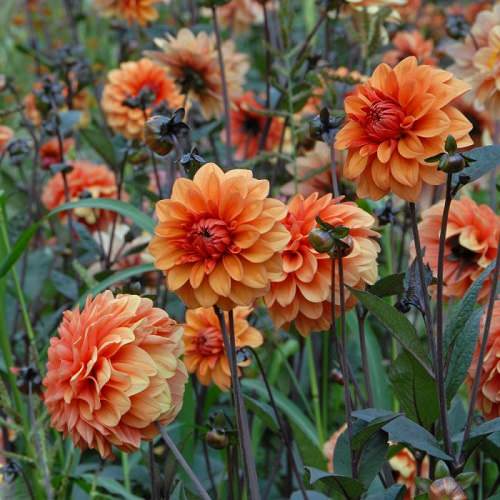
Botanical Name: Dahlia ‘Gwyneth’
| Specification | Description |
|---|---|
| USDA Growing Zones | 5 to 9 |
| Color Varieties | Bright orange flowers with dark green leaves |
| Sun Exposure | Full sun to part shade |
| Soil Needs | Average, medium moisture, well-drained |
| Size (tall x wide) | 30 to 40 cm x 30 to 40 cm (12 to 16 in x 12 to 16 in) |
‘Gwyneth’ is a classy waterlily-style dahlia with flaming orange flowers, pale in the center, that deepens with age. Other orange dahlias include: ‘Jodie Wilkinson,’ ‘Peach Brandy,’ ‘David Howard,’ ‘Sylvia,’ ‘Vulcan,’ and ‘Mrs. Eileen.’
32. Orange Daylily
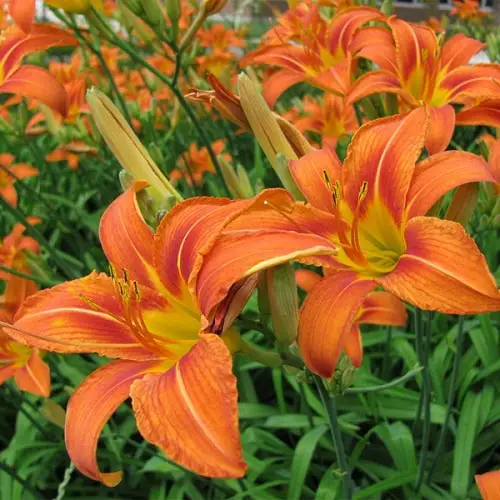
Botanical Name: Hemerocallis fulva (Tawny Daylily)
| Specification | Description |
|---|---|
| USDA Growing Zones | 3 to 10 |
| Color Varieties | Bright orange or orange-red flowers with dark green leaves |
| Sun Exposure | Full sun to partial shade |
| Soil Needs | Sandy, well-drained, acidic, neutral, or alkaline soil |
| Size (tall x wide) | 40 to 150 cm x 40 to 150 cm (16 to 60 in x 16 to 60 in) |
Also known as Tiger Daylily, Tawny Daylily, or Ditch Lily, it forms trumpet-shaped, six-petaled flowers on tall leafless stalks. The flowers last not more than 24 hours, hence the common name ‘Daylily.’
33. Peruvian Lily
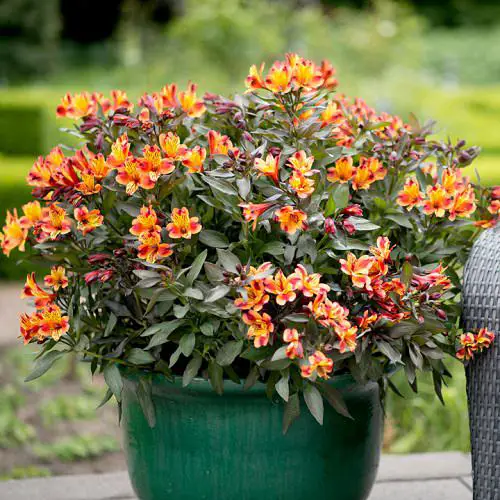
Botanical Name: Alstroemeria ‘Indian Summer’
| Specification | Description |
|---|---|
| USDA Growing Zones | 7 to 10 |
| Color Varieties | Bright orange and golden-yellow flowers with dark green leaves |
| Sun Exposure | Full sun to partial shade |
| Soil Needs | Well-drained, rich in organic matter, pH 5.8 to 6.8 |
| Size (tall x wide) | 60 to 90 cm x 30 to 60 cm (24 to 36 in x 12 to 24 in) |
‘Peruvian Lily’ is an exotic, vigorous perennial that flaunts coppery-orange and golden-yellow flowers. The petals are beautifully patterned with dark burgundy streaks and create a fantastic contrast with lance-shaped rich-bronze foliage.
34. Orange Strawflower
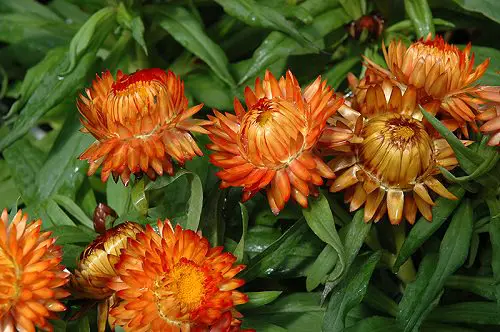
Botanical Name: Bracteantha bracteata ‘Helica Orange’
| Specification | Description |
|---|---|
| USDA Growing Zones | 9 to 11 |
| Color Varieties | Bright orange daisy flowers with yellow eyes and dark green leaves |
| Sun Exposure | Full sun to partial shade |
| Soil Needs | Sandy, well-drained, acidic, neutral, or alkaline soil |
| Size (tall x wide) | 60 cm x 45 cm (24 in x 18 in) |
‘Helica Orange’ produces large, long-lasting, papery, bold orange daisy-like flowers. The narrow leaves stay dark green throughout the season.
35. Trumpet Honeysuckle
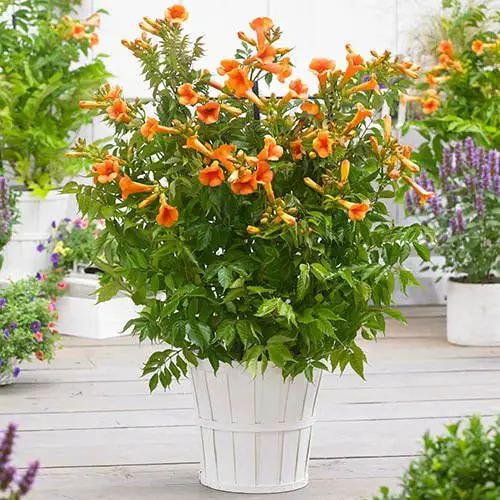
Botanical Name: Lonicera ciliosa
| Specification | Description |
|---|---|
| USDA Growing Zones | 4 to 9 |
| Color Varieties | Orange-red flowers with yellow centers and dark green leaves |
| Sun Exposure | Full sun to part shade |
| Soil Needs | Sandy, well-drained, acidic, neutral, or alkaline soil |
| Size (tall x wide) | 180 to 600 cm x 90 to 180 cm (72 to 240 in x 36 to 72 in) |
Also known as orange honeysuckle, Northwest honeysuckle, or Western Trumpet, it produces clusters of sweetly-scented, nectar-producing trumpet-shaped orange flowers on climbing vines that can grow up to 33 feet (10 m) long.
36. Hummingbird Hyssop

Botanical Name: Agastache ‘Apricot Sunrise’
| Specification | Description |
|---|---|
| USDA Growing Zones | 6 to 9 |
| Color Varieties | Pale golden-orange flowers with dark green leaves |
| Sun Exposure | Full sun |
| Soil Needs | Medium moisture, well-drained |
| Size (tall x wide) | 60 to 90 cm x 30 to 60 cm (24 to 36 in x 12 to 24 in) |
An aromatic plant, it is a must-have specimen if you want to attract hummingbirds to your garden. Its large, orange-pink-flowers can be a great addition to any pollinator-friendly garden.
37. Cat’s Tail Aloe
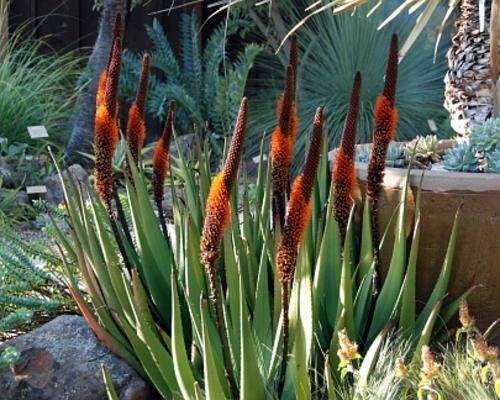
Botanical Name: Aloe castanea
| Specification | Description |
|---|---|
| USDA Growing Zones | 9 to 11 |
| Color Varieties | Orange-red flowers with yellow centers and dark green leaves |
| Sun Exposure | Full sun |
| Soil Needs | Sandy, well-drained, acidic, neutral, or alkaline soil |
| Size (tall x wide) | 180 to 600 cm x 90 to 180 cm (72 to 240 in x 36 to 72 in) |
Growing up to 8-12 feet tall, this succulent has unusual-looking, dark orange-brown flowers that grow mid-winter. It gets its name thanks to the curled and snake-like inflorescence.
38. Cigar Plant
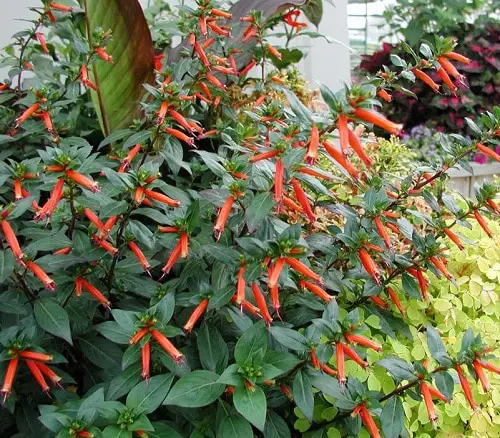
Botanical Name: Cuphea ignea
| Specification | Description |
|---|---|
| USDA Growing Zones | 9 to 12 |
| Color Varieties | Bright red-orange flowers with black and white tips and dark green leaves |
| Sun Exposure | Full sun to partial shade |
| Soil Needs | Sandy, well-drained, acidic, neutral, or alkaline soil |
| Size (tall x wide) | 25 to 61 cm x 23 to 91 cm (10 to 24 in x 9 to 36 in) |
Also known as the firecracker plant, it is a rounded and bushy, evergreen shrub that can reach an impressive height of up to 10-20 feet. It grows tubular, bright orange-red flowers that attract hummingbirds and butterflies.
39. Climbing Penstemon
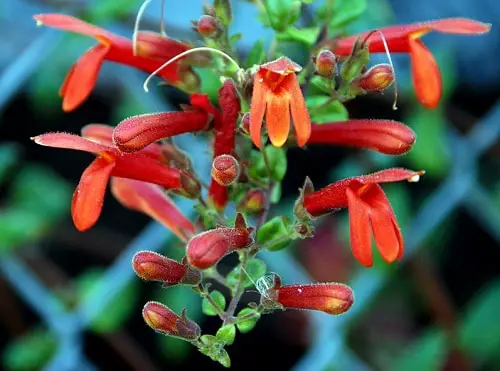
Botanical Name: Keckellia cordifolia
| Specification | Description |
|---|---|
| USDA Growing Zones | 3 to 9 |
| Color Varieties | Bright red-orange flowers with dark green leaves |
| Sun Exposure | Full sun to part shade |
| Soil Needs | Sandy, well-drained, acidic, neutral, or alkaline soil |
| Size (tall x wide) | 180 to 600 cm x 90 to 180 cm (72 to 240 in x 36 to 72 in) |
A drought-tolerant plant, it can grow up to 4-6 feet tall and produces hairy inflorescences of tubular flowers in pale orange-red hues that match well with its oval and heart-shaped leaves. It does well in bright and shaded spots.
40. Rose
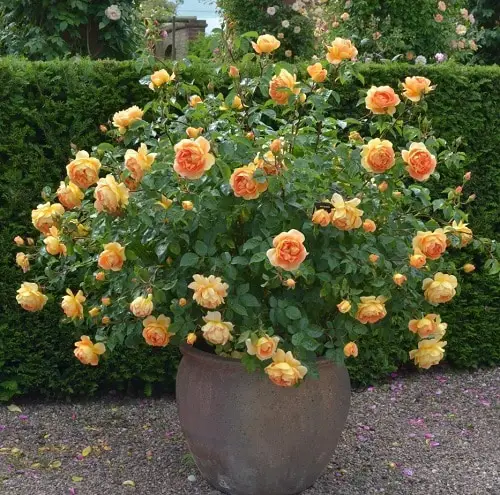
Botanical Name: Rosa ‘Pat Austin’
| Specification | Description |
|---|---|
| USDA Growing Zones | 5 to 9 |
| Color Varieties | Orange-pink flowers with dark green leaves |
| Sun Exposure | Full sun to part shade |
| Soil Needs | Average, medium moisture, well-drained |
| Size (tall x wide) | 30 to 40 cm x 30 to 40 cm (12 to 16 in x 12 to 16 in) |
The large, deeply cupped flowers of Pat Austin come in a beautiful shade of Orange-copper. The blooms have a unique contrasting shade that makes them immensely attractive. The flowers also have a mild tea/clove scent.
41. Marigold
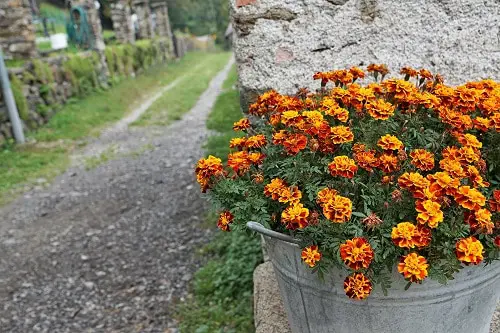
Botanical Name: Tagetes spp.
| Specification | Description |
|---|---|
| USDA Growing Zones | 2 to 11 |
| Color Varieties | Yellow, orange, white, red, gold, bicolor |
| Sun Exposure | Full sun |
| Soil Needs | Well-draining, evenly moist |
| Size (tall x wide) | 6 to 18 inches x 8 to 18 inches (15 to 45 cm x 20 to 45 cm) |
If you are looking for a flower that blooms all summer long in a bright shade of orange, then this is the plant for you! The large, pompom double flowers come in shades of yellow, gold, and orange. The plant does best in the sun.
42. Orange Trumpet Vine
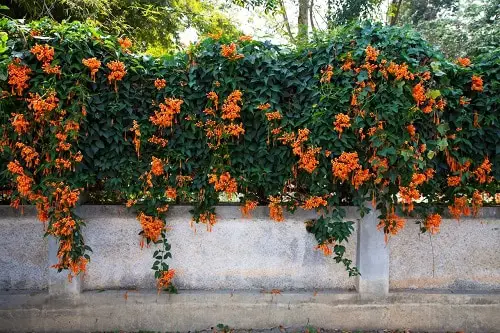
Botanical Name: Pyrostegia venusta
| Specification | Description |
|---|---|
| USDA Growing Zones | 9 to 11 |
| Color Varieties | Bright red-orange flowers with yellow centers and dark green leaves |
| Sun Exposure | Full sun to partial shade |
| Soil Needs | Sandy, well-drained, acidic, neutral, or alkaline soil |
| Size (tall x wide) | 8 to 12 meters x 1.5 to 2.5 meters (26 to 39 feet x 5 to 8 feet) |
A vigorous and fast-growing vine, it blooms all winter long. The dazzling shade of its vibrant Orange flowers creates quite a spectacle in full sun. It makes for a great lush ground cover or a climbing vine, both.
43. Frangipani
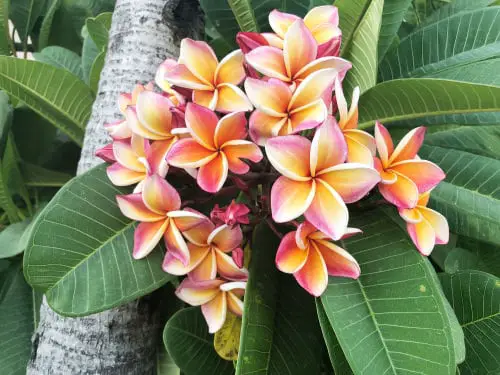
Botanical Name: Plumeria
| Specification | Description |
|---|---|
| USDA Growing Zones | 10 to 12 |
| Color Varieties | White, yellow, orange, pink, or red flowers with dark green leaves |
| Sun Exposure | Full sun |
| Soil Needs | Sandy, well-drained, acidic, neutral, or alkaline soil |
| Size (tall x wide) | 3 to 7.5 meters x 3 to 7.5 meters (10 to 25 feet x 10 to 25 feet) |
This is a delicate tropical flower that symbolizes devotion and strength. You can choose to include frangipani in arrangements anywhere in the house to welcome guests with its rich scent and orange hue.
44. Cockscomb
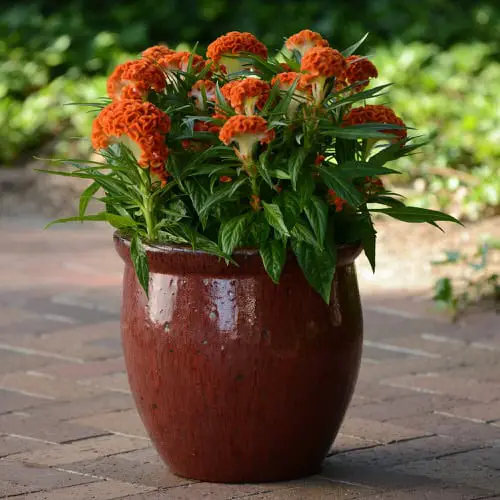
Botanical Name: Celosia cristata
| Specification | Description |
|---|---|
| USDA Growing Zones | 9 to 12 |
| Color Varieties | Bright red, pink, orange, yellow, or white flowers with dark green leaves |
| Sun Exposure | Full sun |
| Soil Needs | Well-draining, evenly moist soil |
| Size (tall x wide) | 15 to 45 cm x 20 to 45 cm (6 to 18 in x 8 to 18 in) |
This plant derives its name ‘cockscomb’ from how the flower looks like the head of a rooster. It is resistant to most diseases and grows equally well indoors or outdoors.
45. Flowering Maple
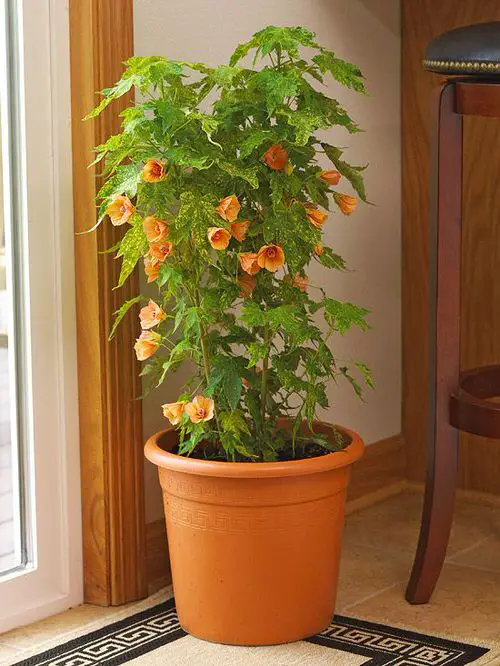
Botanical Name: Abutilon x hybridum
| Specification | Description |
|---|---|
| USDA Growing Zones | 9 to 10 |
| Color Varieties | White, yellow, orange, red, pink, salmon, or bicolored |
| Sun Exposure | Full sun to partial shade |
| Soil Needs | Well-drained, compost-enriched, neutral pH |
| Size (tall x wide) in CM | Up to 300 x 300 cm |
Flowering maple has maple-shaped leaves and bell-shaped flowers. These subtropical plants are sensitive to frost, so they should be moved indoors over the winter unless you want to grow them as an annual.
Here are the best Orange Flowers in Florida
46. Montbretia
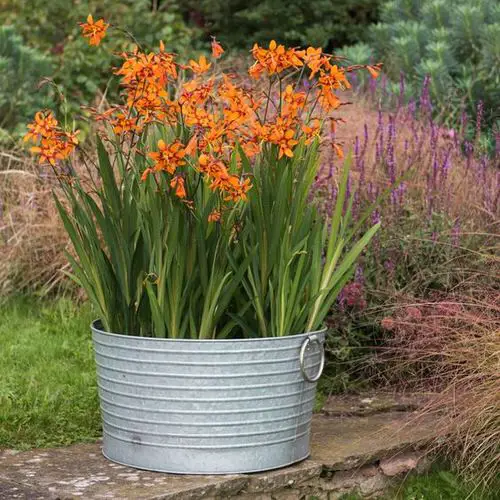
Botanical Name: Crocosmia ‘Lucifer’
| Specification | Description |
|---|---|
| USDA Growing Zones | 6 to 9 |
| Color Varieties | Scarlet red, tubular flowers with yellow throats |
| Sun Exposure | Full sun, some afternoon shade in hot areas |
| Soil Needs | Moderately fertile, slightly acidic, humus-rich, moist but well-drained |
| Size (tall x wide) | 90 cm x 45 cm (36 in x 18 in) |
Montbretia is commonly seen in floral arrangements, and the foliage resembles that of the iris, while its flowers can remind you of freesias. The plants grow around 2-4 feet tall and should be protected with a layer of mulch over the winter.
47. Iris
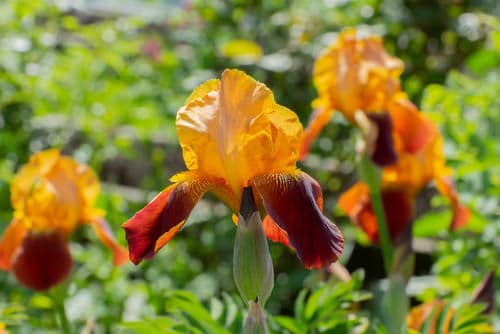
Botanical Name: Iris ‘Maid Of Orange’
| Specification | Description |
|---|---|
| USDA Growing Zones | 3 to 9 |
| Color Varieties | Creamy orange flowers with paprika-colored beards |
| Sun Exposure | Full sun, some afternoon shade in hot areas |
| Soil Needs | Average, well-draining, neutral pH soils |
| Size (tall x wide) | 60 cm x 60 cm (24 in x 24 in) |
Like roses, the Iris genus is also quite diverse. Iris flowers come in various shades and have drooping outer petals with upright inner petals. Removing spent flowers can help to prolong the blooming, which typically occurs from late spring into summer.
48. Red Hot Pokers
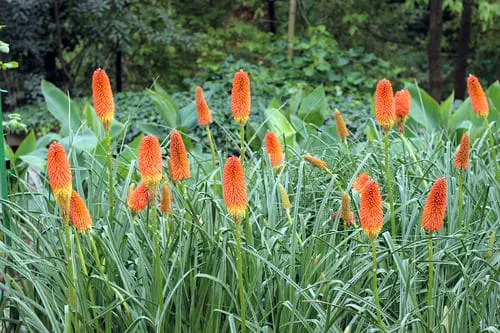
Botanical Name: Kniphofia uvaria
| Specification | Description |
|---|---|
| USDA Growing Zones | 5 to 9 |
| Color Varieties | Bright red, orange, yellow, and other colors |
| Sun Exposure | Full sun, some afternoon shade in hot areas |
| Soil Needs | Well-drained, neutral pH |
| Size (tall x wide) | 90 cm x 60 cm (36 in x 24 in) |
Red Hot Poker, also called Torch Lilies, is named because of the bright orange blooms that grow on top of a long, slim stem, making them look like poker or torch.
49. Smokebush
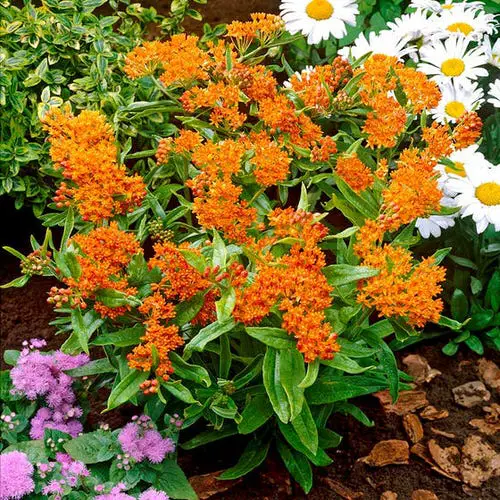
Botanical Name: Buddleja madagascariensis
| Specification | Description |
|---|---|
| USDA Growing Zones | 9 to 11 |
| Color Varieties | Yellow, orange, or pink fragrant flowers |
| Sun Exposure | Full sun, some afternoon shade in hot areas |
| Soil Needs | Poor, well-drained, neutral pH soils |
| Size (tall x wide) | 4 m x 2.4 m (13 ft x 8 ft) |
The panicles of yellow-orange to bright Orange flowers match really well with green, lance-shaped foliage. It is also one of the best plants to attract butterflies.
50. Orange Snapdragon
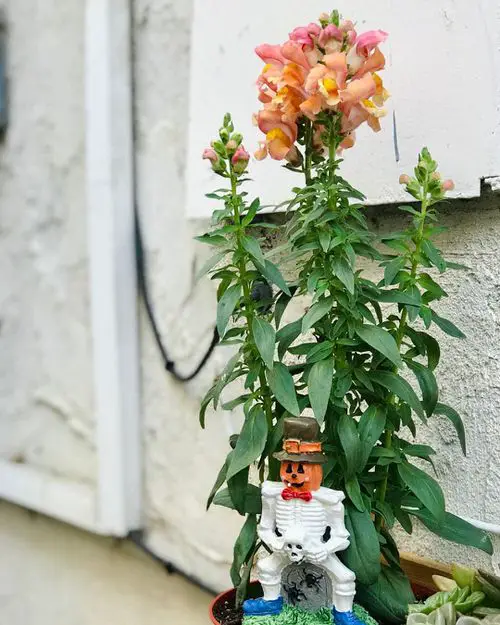
Botanical Name: Antirrhinum
| Specification | Description |
|---|---|
| USDA Growing Zones | 7 to 11 |
| Color Varieties | Bright orange, single or semi-double flowers |
| Sun Exposure | Full sun, some afternoon shade in hot areas |
| Soil Needs | Moist, well-draining, neutral pH soils |
| Size (tall x wide) | 15 cm x 30 cm (6 in x 12 in) |
If, as a gardener, you’re looking for a flower that stands out with bright blooms, then look no further than a tall snapdragon! A symbol of growth and grace, this flower can be incorporated into an arrangement for any occasion celebrating a new journey.
51. Chinese Hibiscus
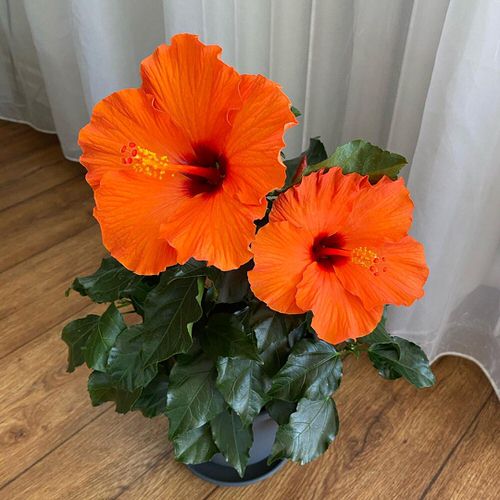
Botanical Name: Hibiscus rosa-sinensis
| Specification | Description |
|---|---|
| USDA Growing Zones | 9 to 11 |
| Color Varieties | Brightly colored flowers in various shades of red, orange, yellow, pink, and white |
| Sun Exposure | Full sun, some afternoon shade in hot areas |
| Soil Needs | Moderately fertile, well-draining, neutral pH soils |
| Size (tall x wide) | 2.5 m x 1.5 m (8 ft x 5 ft) |
One of the most beautiful flowers you can grow, Hibiscus shines with its large, 5-petalled flowers that range in color from orange to yellow or crimson.
52. Orange Bells
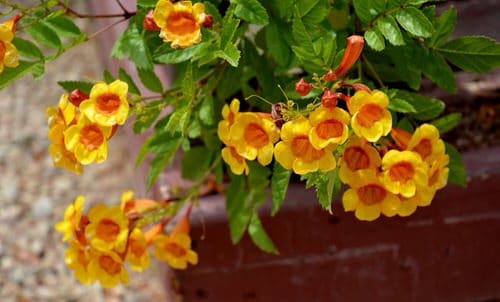
Botanical Name: Tecoma x alata ‘Orange Jubilee’
| Specification | Description |
|---|---|
| USDA Growing Zones | 7 to 11 |
| Color Varieties | Bright orange, trumpet-shaped flowers |
| Sun Exposure | Full sun, some afternoon shade in hot areas |
| Soil Needs | Medium to low water, well-draining, neutral pH soils |
| Size (tall x wide) | 3 m x 2.4 m (10 ft x 8 ft) |
This hardy shrub produces clusters of bright orange, trumpet-shaded flowers. The plant continues to bloom from late spring until the first frost.
53. Orange Alstroemeria
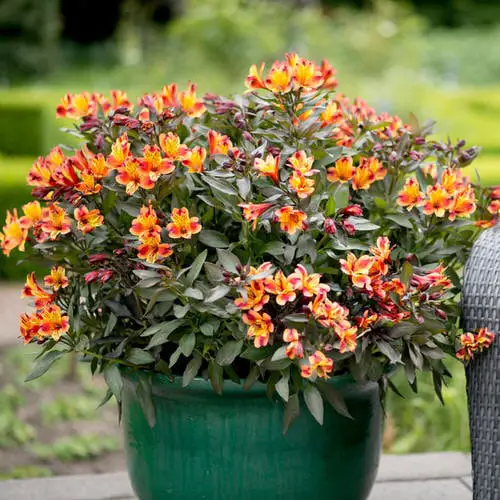
Botanical Name: Alstroemeria ‘Orange Glory’
| Specification | Description |
|---|---|
| USDA Growing Zones | 7 to 11 |
| Color Varieties | Bright orange, single or semi-double flowers with attractive patterns and markings on the inside |
| Sun Exposure | Full sun, some afternoon shade in hot areas |
| Soil Needs | Moist but well-drained, neutral pH soils |
| Size (tall x wide) | 60 cm x 60 cm (24 in x 24 in) |
These beautiful orange funnel-shaped flowers grow in clusters of 6 to 8. The blooms match well with the narrow, lance-shaped leaves.





where I found theSeed of flowers.
Such incredible advice from so many awesome sources! I love it!
I have found a beautiful Orange petal flower out in the Arizona desert I can not identify. It’s center has purple hairs and it’s base has black spots. There’s only 3 petals. It stood only 6 inches from the ground.
This article is very informative and inspiring. I love the variety of orange flowers you have featured here. I have a question about the orange begonias. How do you care for them in the winter? Do you have to bring them indoors or cover them with mulch? I would appreciate any tips you can share. Thank you! 😊
This article is very informative and inspiring. I love the variety of orange flowers you have featured here.